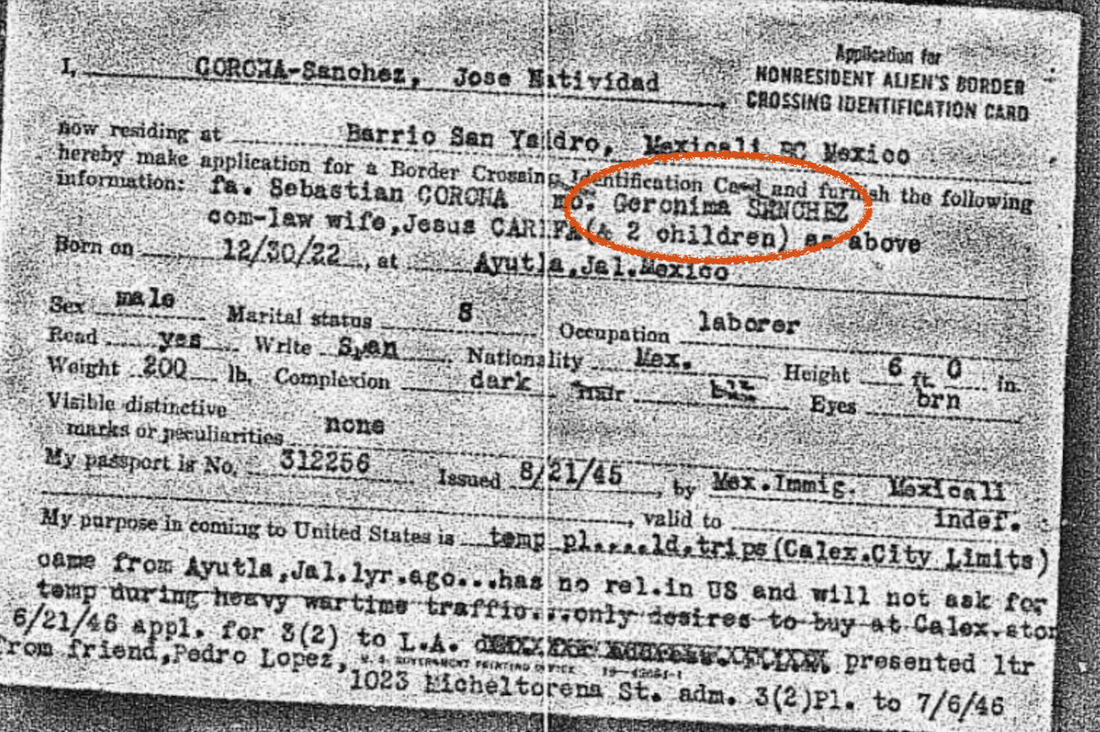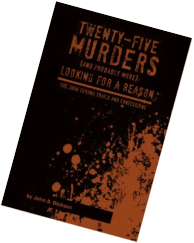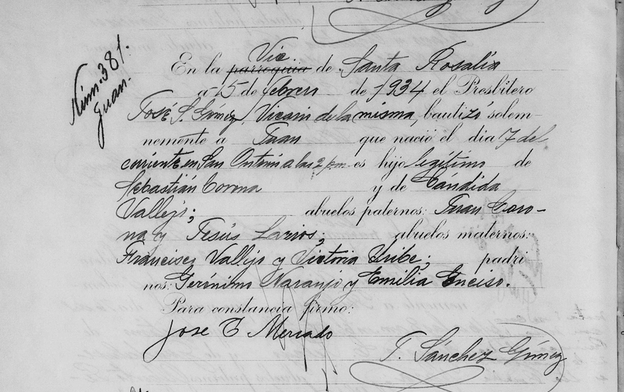|
My search for Juan Corona began with the statement that he was a 'primo' or cousin to the Medina family, which became the ultimate research question: is this man truly related to my husband? Or was this simply an erroneous assumption, based on family lore? Let's get to the answer. Follow the brother (and the father and the mother and aunt...) An important technique in genealogical research is to expand the scope to multiple family members - beyond those of interest. Records of brothers, sisters, aunts, and uncles can reveal critical insights into the lives of direct ancestors. Indeed, a full picture of each family member enriches the stories of all. This proved to be the case in my search for Juan Corona. The Corona family entry in the 1930 Mexico National Census suggests that Natividad and Juan were half-brothers. With confirmation that Cándida Uribe was the mother of Juan, and the implausibility that she was the mother of Natividad (due to their proximity in age), the next step was to identify Natividad's mother and perhaps find a clue to the relationship to the Medina family. The breakthrough For Mexican research, I rely heavily on the FamilySearch database, filled with hundreds of millions of records from the Catholic Church and the Regístro Civil - some indexed and others not. Using the search tools available for the indexed records, I looked for more information about Sebastian Corona and his first marriage (children, marriage record, etc.). No luck. There simply were no indexed records in FamilySearch matching this family. I then began the old-fashioned (and incredibly time-consuming) process of searching the unindexed Civil Registration records page-by-page. The problem with this approach was that I was using erroneous information discovered in books written about Juan Corona. Nearly all references I consulted (which largely included research conducted by lawyers, and not genealogists) suggested that the family was from Autlán. Incorrect. It appeared I had hit a brick wall. And then, using the Ancestry.com database of Mexico to U.S. Border Crossings, I located a record for Natividad. It proved to be the wrecking ball that busted through my brick wall. Within this one document is Natividad's date and place of birth, the name of his wife, a photo, and...the name of his mother! This piece of information was the key to unlocking the connection to the Medina family. Using this new information (and, in October, the release of Ancestry.com's collection of indexed Mexican Civil Registration records), I quickly discovered the rest of the story. Natividad Corona was born on December 30th, 1922, as indicated on the border crossing document. This was supported by the civil registration of his birth. Interestingly, he is listed as 'hijo ilegítimo' which would explain the reason for no marriage records for Sebastian and Gerónima. He died in Guadalajara in 1973 (following the storyline of most investigators in the U.S. that he fled to Mexico during his brother's trial). Gerónima! The next and final step to answering the research question was to build the family tree of Gerónima Sanchez. It didn't take long to tie into a tree I had long researched. My husband's great grandmother was Francisca Sanchez Ramos. The first record I discovered, though tragic, connected Gerónima to Sebastian Corona and to Francisca Sanchez. It was a 1927 death record for Señora Gerónima Sanchez, in which the informant was Sebastian Corona, and the parents were listed as Pascual y Basilia Ramos. Pascual and Basilia were Francisca's parents, as well. Natividad Corona's mother, Gerónima, was my husband's great grandmother's sister. Put another way, Natividad (Juan's half-brother) was my husband's grandfather's cousin. Ultimately, this confirmed that Juan Corona and my husband are not related. Unfortunately, it never quite resolved the question as to whether or not I married an axe murderer: Natividad was also suspected of committing the crimes.
Eh. I'll take my chances. ;)
7 Comments
People are strangely fascinated by serial killers and their crimes. In fact, murder mysteries, in general have captured the attention of the masses for centuries. Perhaps it is no surprise then, that before researching the connection of Juan Corona to my husband's family, I immediately began to scour newspapers and libraries for information about the ghastly crimes that he committed. What does history tell us? One look on Wikipedia will tell you that Juan Corona was convicted of murdering 25 migrant farm workers in 1973. He was sentenced to life in prison, and continues to serve that sentence today in Soledad, California. Keep searching, and you will find that the murders were gruesome, allegedly carried out with a machete. However, 'history' takes many forms on the internet, and much of it is fiction. Only through consulting well-documented research will you find an accurate depiction of the crimes, including the evidence used at trial. Twenty-five Murders (and probably more): Looking for a Reason, a book by John B. Dickson, includes an in-depth review of the two trials (there was an appeal following the first conviction) and the circumstances surrounding the case.
Cousin Juan Corona The Medina family remembers Juan Corona as the brother of their 'cousin' Natividad Corona. While they spent years of their youth with Natividad, they knew very little of Juan. With no recollection of exactly how they are related, my husband's aunts and uncles do know that Natividad was called 'cousin' by their father, Jose Jesus Medina, and was a 'padrino' to one of them. The term, 'cousin,' of course, does not make for an easy starting place in genealogical research. I meet a 'cousin' at nearly every genealogy conference I attend. However, it's not an impossible place to begin - they knew each other and lived in the same small town near Guadalajara. So, I began by building the family tree of Juan Corona. Juan Corona was born on February 7, 1934 in Ayutla, Jalisco, Mexico to parents Sebastian Corona Larios and Cándida Vallejo Uribe. Through my research, I located not only the baptismal record for Juan, but for several of his brothers and sisters, as well. While I was unable to locate the border-crossing documents that would indicate when he traveled to the United States, several biographies of his life suggest that he was living in the Sacramento region by the 1950s. Based on this initial two-generation tree, there is no relation to the Medina family. So, I continued with Natividad. Though his tree is the same, I had hoped I would find something among his documents that would fill in the gaps. Natividad, the brother
The search for Natividad's birth records was a challenge. I used multiple databases, and various versions of his parents' names. Though I did uncover a 1930 Mexico census that listed an approximate age (as well as other siblings), a census does not confirm the exact birth date. ...And then I saw it. Guadalupe and Natividad were 12 and 10, respectively in 1930. The father, Sebastian, was 40. The mother, Cándida, was 22. Now, there are young mothers, of course. But, this is not what occurred here. She would have been 10 years old at the birth of her first child. No, this must be a second marriage for Sebastian. Perhaps the mother of Natividad and Guadalupe would reveal the connection to the Medina family? Research begins with a question; in genealogy, this question concerns a person. But! The question is more than just “when was my great-grandfather born?” and “what was the maiden name of my 3rd great-grandmother?” These research questions are bounded by dates and names and lack a critical element of genealogical research: context. In fact, if the researcher restricts her questions to the ancestor alone, answers will be elusive. The research questions must concern a person connected to a particular place at a particular time. Indeed, it is the context - the land, the events, the culture - that creates compelling stories of our past. For that reason, I’d like to share some of the questions that guided my meandering research of Anthony’s life and take you on the journey of discovering the answers.
Finding the answers to these questions (and others) was not easy; and as of yet, I’ve not been able to conclusively answer them all. However, by consulting multiple and varied historical records, I have pieced together the historic (and emotional) events of Anthony’s life. Anthony is born Anthony Hensler was born in Missouri in 1843 - or perhaps 1844. Actually, maybe 1846. Let’s look at the evidence: Anthony appears in the 1860 U.S. Census, at the age of 14.  According to his enlistment papers in the U.S. Army, he was 21 years of age on January 5, 1864. And, in an affidavit in his wife’s pension records, it is stated that he was 18 years old when he enlisted (in 1861). His parents were married in 1850. Wait. 1850?! Now I’m confused. Which is correct - Anthony was born between 1843 and 1846 (before his parents were married) or was he born later? Or perhaps the date of his parent’s marriage is incorrect. Let’s explore each possibility separately. The marriage of Valentine Hensler and Theresa Fay is recorded in both the pension records for Valentine, as well as in the church records in St. Louis, where the marriage took place. The date, January 22, 1850, is the same in both documents. One is an indirect record and the other a direct one, filed one month after the event. Given these pieces of evidence, there is little doubt of the accuracy of this date. Next, let’s consider the possibility that Anthony was born later than 1846, after his parents were married. To explore this, we look to his enlistment papers in 1861. If he was born after the marriage of Valentine and Theresa in 1850, he would have been barely 11 years old at the time of enlistment. While there were certainly young men who entered the Army during the Civil War, 11 is exceptionally young. What is more, his younger brother, Valentine, appears to have been born in 1850. This leaves us to conclude that Anthony was born out of wedlock to Valentine and Theresa. (Heaven’s no!) But wait, there is another possibility. Anthony’s alias is Arthur Fay, the maiden name of Theresa. With this information, perhaps we should consider the notion that Anthony (or Arthur) is not the son of Valentine Hensler. Dun dun dun. Let’s leave the question of his birthdate for a moment and examine his military record. Was he truly a prisoner at Andersonville, one of the most infamous prisons in U.S. history? A prisoner of war According to his military record, Anthony Hensler enlisted with the 53rd Regiment of Army Volunteers in Ottawa, Illinois on December 15, 1861. With the exception of a thirty-day furlough in October of 1863, he was consistently present for muster rolls every month for two years. During this time, his regiment traveled hundreds of miles from Illinois to Tennessee, Mississippi, and Georgia, and fought in numerous campaigns. In October of 1862, Anthony was wounded at the Battle of Hatchie in Hardeman County and McNairy County, Tennessee. In January of 1864, he reenlisted while in Mississippi. Again, Anthony is continuously present in the muster rolls, until July of that year, when:  Anthony Hensler is listed as "missing" from July 22, 1864 through February, 1865 - that is nearly 7 months. Then, in the March/April 1865 muster roll, the record notation is revised to show that he was “taken prisoner” at Atlanta, Georgia. And finally, in the last pages of his military record, there is a Memorandum From Prisoner of War Records. This document confirms his capture and imprisonment at Andersonville. What is more, earlier this year, I visited the National Historic Site, and discovered his name among the records there. A chilling discovery. In fact, Anthony Hensler was a prisoner at Andersonville Prison for at least 9 months - an abhorrent experience that I cannot put into words. Rather, I will share an excerpt from the memoirs of another survivor of that wretched place (warning: this is a graphic depiction): "...a surgeon reports that in August and September there were more than 3000 sick lying on the bare ground partially naked; some had broken limbs, some were gangrened, some suffering with scurvy, some with chronic diarrhea...Lice, fleas, and incredible clouds of mosquitoes deprived them of sleep, and drove them mad...Many voluntarily crossed the dead line in order to be shot. Attracted by the smell of this living carrion, flocks of vultures, the "turkey buzzard" of the South, soared high in the air over this den of human putridity...If your readers are shocked...let me assure them that I have not told half of the reality." Despite this troublesome discovery about my great-great grand uncle, the research continued. There were still more questions to be answered, particularly regarding his wife, Cinderella and his life after the war. I will share the answers to these remaining questions in the next and final post on Anthony's life.
|
AuthorLisa Medina, here to share the history of families - one story at a time. . Archives
May 2016
Categories
All
Copyright © 2020-2021 Lisa Medina Genealogist & Family Historian
|













 RSS Feed
RSS Feed
